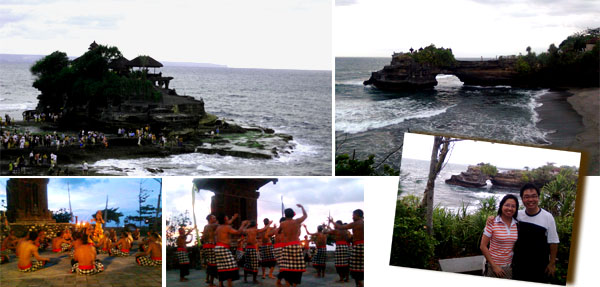A walk down Legian Road followed by a round at Kuta Square and Matahari Square made a "home run" shopping for us. Kuta and Legian are the best places for shoppers to unleash their "talent" with hundreds of small shops-souvenirs, clothes, shoes, surfing equipments, glasses, bars, bistros, pubs... all of them lined up, awaiting to be explored.
Upper row: Shop lots along Legian Road. For those who has strong legs, they are hundreds of shops lined along 4 km of Legian Road for you to explore. Lower row: Shop lots around Kuta Square and Matahari Square.
Stuffs available in Bali: Wind chimes, batiks, casual clothes, CD and DVD, decorative items, shoes, bags.
Balinese Batik and picture drawn by local painters are something unique that we can bring back home as souvenir. We went to visit local batik manufacturer (Tohpati) and local picture painters (Batuan) on our way up to Mount Kintamani. The prices offered there were much more cheaper than what we could get in Denpasar. Clockwise from upper left: photo taken beside local weaver, local painters, pictures available for sales, and local Balinese lady painting batik.
Our group photo at Dewa Putu Toris Art Gallery, Batuan. The gallery was big with hundreds (maybe thousands) of pictures, drawn by local artists and painters. We bought some Balinese painting for quite reasonable price (compared to those sold in our own country)
Beautifully decorated Matahari Square.
Some interesting facts and findings in Bali, firstly, the flower offerings given by Hindus to their Gods twice to trice daily, can be seen everywhere. Secondly, many motorbikes on the road. Motorbikes for rental are available in every street. The boothes offering tour packages are available every hundred meters, offering tour packages with good bargained price. However, beware of the company that comes out with unreasonably low price, as they might offer you a trip that might ruin your nice day. Then, taxis with standard meter are mostly blue.
In Bali, there is no 7-11. What you can see are the substitutes, Mini Marts, one in every 500 metersBig statues always available at the middle of roundabouts showing the stories taken from either Ramayana or Mahabrata. Last but not least, beware of the money changers with super attractive rates, they are good in tricks (we experienced it once). They will make you loss more than those with reasonable rates. Always go for the money changers that produce receipts. They will offer less fuss and problems.
Clockwise from upper left: Flower offerings; Motors for rent available just beside the road; Blue taxi; Sign of Mini Mart; Memorial for the victims of 2002 bombing tragedy in Legian Road; Statue showing a story from Hindu's epic (Ramayana and Mahabrata); One of the hundreds of booths that offer tour packages.
As long as we had noticed, Bali's streets were safe, at least around Kuta and Legian area. Most of the shops along the main streets stayed operational until 9 or 10 pm, and some of them, remained open after 11 pm. Most of the people there can speak simple English. Malay Language or Indonesian Language is widely understood (we can speak fluence Malay Language and had no problem to communicate with the locals).

Night at Legian Road, Bali. Photos were taken around 10 pm. The street was still bright with many visitors.
Lastly, the food. We could find a lot of food around Legian and Kuta- Brazilian, German, Malay and Padang (Halal), Indian, Australian, Japanese, Korean, Chinese and many many more. For us, we prefered Malay or Indonesian food here (they just tasted like Malaysian food) for their reasonable price and wide availability.
Clockwise from upper left: Western food; Local fried rice; Betty dining in a local restaurant; Indonesian food (satay, fried rice, and fried potatoes); Balinese curry tomyam.
For more information about Bali, please refer to some of the website like Bali star island, Bali 123, and Bali-online.
High resolution of photos of Bali is available on our Travel Photo Gallery. Back to All Our Destinations.
[Bali Page 1] [Bali Page 2] [Bali Page 3] [Bali Page 4]





















































